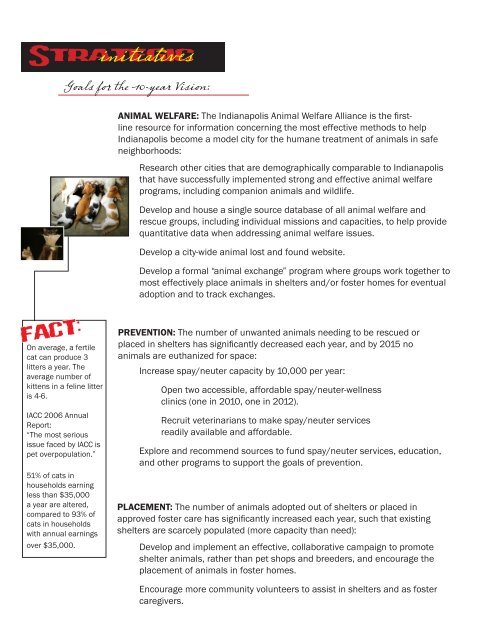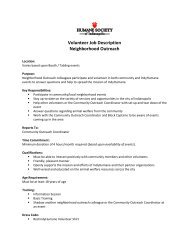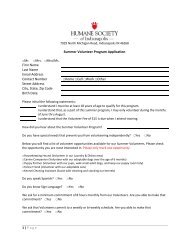download the Indianapolis Animal Welfare Alliance Executive ...
download the Indianapolis Animal Welfare Alliance Executive ...
download the Indianapolis Animal Welfare Alliance Executive ...
You also want an ePaper? Increase the reach of your titles
YUMPU automatically turns print PDFs into web optimized ePapers that Google loves.
initiatives<br />
Goals for <strong>the</strong> 10-year Vision:<br />
ANIMAL WELFARE: The <strong>Indianapolis</strong> <strong>Animal</strong> <strong>Welfare</strong> <strong>Alliance</strong> is <strong>the</strong> firstline<br />
resource for information concerning <strong>the</strong> most effective methods to help<br />
<strong>Indianapolis</strong> become a model city for <strong>the</strong> humane treatment of animals in safe<br />
neighborhoods:<br />
Research o<strong>the</strong>r cities that are demographically comparable to <strong>Indianapolis</strong><br />
that have successfully implemented strong and effective animal welfare<br />
programs, including companion animals and wildlife.<br />
Develop and house a single source database of all animal welfare and<br />
rescue groups, including individual missions and capacities, to help provide<br />
quantitative data when addressing animal welfare issues.<br />
Develop a city-wide animal lost and found website.<br />
Develop a formal “animal exchange” program where groups work toge<strong>the</strong>r to<br />
most effectively place animals in shelters and/or foster homes for eventual<br />
adoption and to track exchanges.<br />
On average, a fertile<br />
cat can produce 3<br />
litters a year. The<br />
average number of<br />
kittens in a feline litter<br />
is 4-6.<br />
IACC 2006 Annual<br />
Report:<br />
“The most serious<br />
issue faced by IACC is<br />
pet overpopulation.”<br />
51% of cats in<br />
households earning<br />
less than $35,000<br />
a year are altered,<br />
compared to 93% of<br />
cats in households<br />
with annual earnings<br />
over $35,000.<br />
PREVENTION: The number of unwanted animals needing to be rescued or<br />
placed in shelters has significantly decreased each year, and by 2015 no<br />
animals are euthanized for space:<br />
Increase spay/neuter capacity by 10,000 per year:<br />
Open two accessible, affordable spay/neuter-wellness<br />
clinics (one in 2010, one in 2012).<br />
Recruit veterinarians to make spay/neuter services<br />
readily available and affordable.<br />
Explore and recommend sources to fund spay/neuter services, education,<br />
and o<strong>the</strong>r programs to support <strong>the</strong> goals of prevention.<br />
PLACEMENT: The number of animals adopted out of shelters or placed in<br />
approved foster care has significantly increased each year, such that existing<br />
shelters are scarcely populated (more capacity than need):<br />
Develop and implement an effective, collaborative campaign to promote<br />
shelter animals, ra<strong>the</strong>r than pet shops and breeders, and encourage <strong>the</strong><br />
placement of animals in foster homes.<br />
Encourage more community volunteers to assist in shelters and as foster<br />
caregivers.





